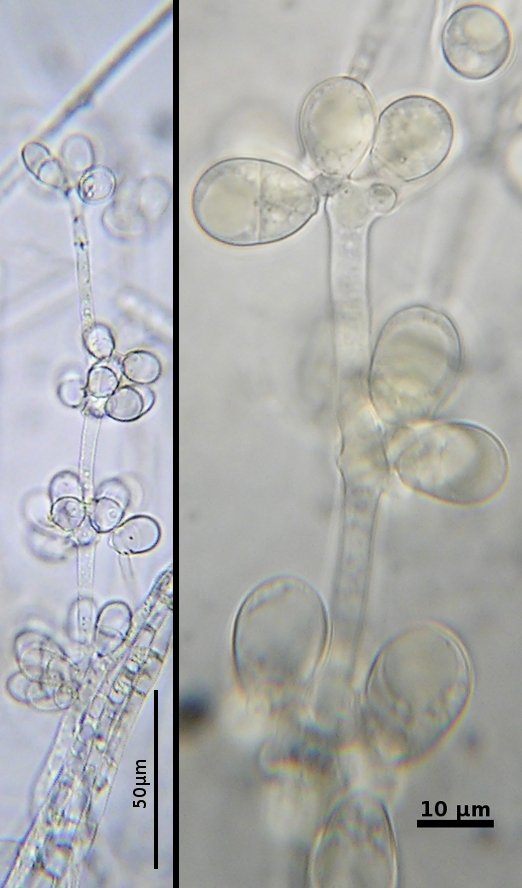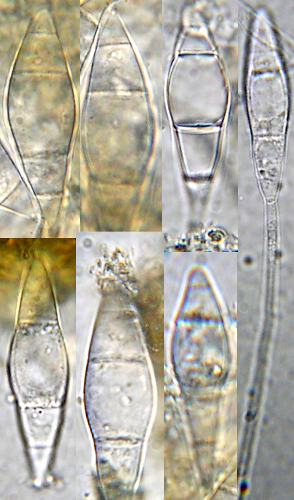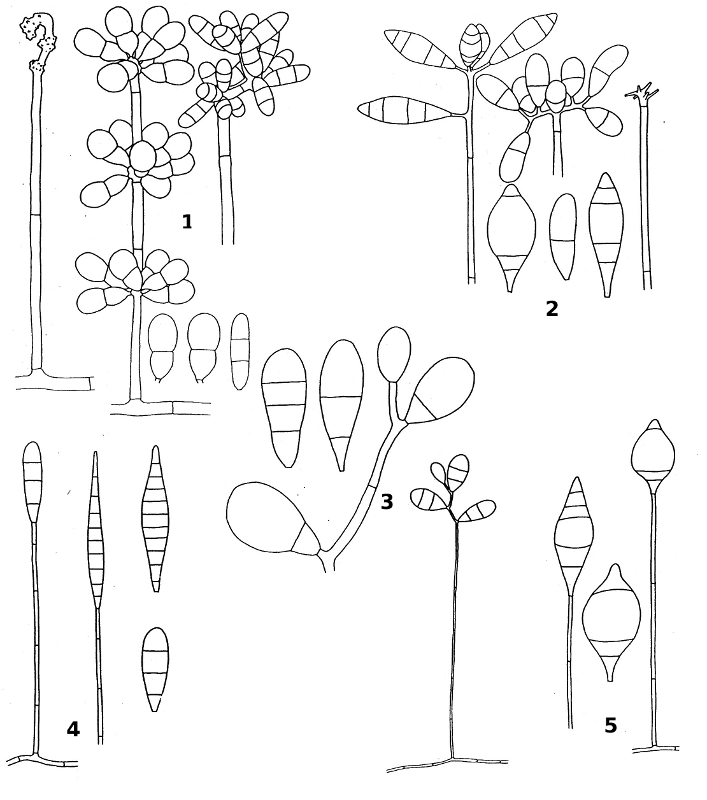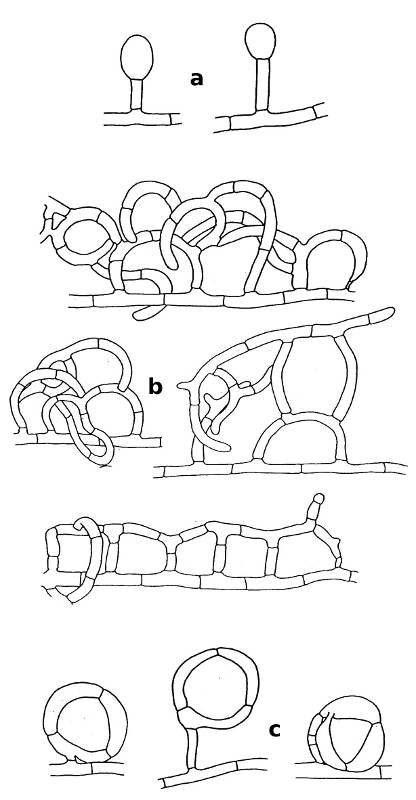Main page <> Index of descriptions <> Previous description <> Anamorphs of Orbiliaceae <> Next description
Anamorphs of Orbiliaceae




Characterized by tall, colourless conidiophores bearing clusters of spores (conidia) at the tip and often at several swollen points below. The conidia are colourless, 2- to many-celled, and leave conspicuous scars or pegs on the conidiophore when released.
Anamorphs of the Orbiliaceae are probably all predators on eelworms (nematodes). They employ several devices to capture these microscopic worms, illustrated in the drawing at left. These structures are (a) sticky knobs, (b) sticky networks of loops and (c) constricting rings. Constricting rings work something like the well-known Venus' fly trap. When a nematode, intent upon searching for bacteria and other small edible particles, enters one of the rings, the cells of the ring suddenly inflate and the nematode becomes entrapped. The constricting action of these rings is so powerful that the nematode is almost cut in half. Sticky networks are less theatrical than constricting rings, yet they have their own brand of terror. When a nematode enters the network of loops it is held by a very strong "glue" and is unable to escape. In both cases, the captured worm first struggles wildly and then seems to become comatose. The fungus then sends its filaments into the worm and digests it. When it has obtained sufficient nutrients from its prey the fungus reproduces by producing clusters of conidia at the tops of long conidiophores.
Thanks to the groundbreaking research of Drs. Donald Pfister and Michael Liftik (Pfister, 1994, 1997; Pfister and Liftik, 1995) we now have a much better understanding of the life histories of these interesting fungi. These authors provided convincing evidence that this group of anamorphs includes the asexual expression of the well-known discomycete genus Orbilia, a group of ascomycetes commonly found on dead wood, decomposing plant materials, soil and dung. Although species of Orbilia were previously thought to be simple decomposers we now realize they can be active predators. The photograph above left shows a strain isolated from the floor of an abandoned beaver lodge where it was probably trapping nematodes. Immediately o the right of this photo is one found growing on porucupine dung harbouring large numbers of nematodes.
Much of the literature dealing with these fungi follows the practice of separate names for the asexual stages of Ascomycota and basidiomycota (see the discussion of "One Fungus-One Name" in the chapter on classification for more details of this issue). In using this literature you will undoubtedly encounter several generic names in use for the anamorphs of Orbiliaceae, all based on details of the spore-bearing structures. Some of these "genera" are illustrated in the middle drawing as 1)Arthrobotrys, 2) Candelabrella, 3) Geniculifera, 4) Dactylella and 5) Monacrosporium. The photograph above represents the Arthrobotrys type of anamorph. Although all of these "genera" probably represent anamorphs of the genus Orbilia they do not appear to be good indicators of relatedness among its species. Mycologists now believe that the type of capturing structure is a better indicator of genetic relationships (Hagedorn & Scholler, 1999; Seifert et al., 2011).
Orbilia species are undoubtedly important in controlling numbers of nematodes, including those causing damage to agricultural crops. To study them it is necessary to first have a culture of nematodes. We maintain them on a weak medium spread with yeast or bacteria. Dehydrated pea soup mix also seems to be good food for nematodes. To see the anamorphs and trapping structures, a pinch of soil is introduced into the nematode culture. After a few days the traps will become abundant.
Classification: Orbiliaceae (Orbiliomycetes). Although the sexual stages resemble one of the inoperculate discomycetes, they may not be closely related. Dr Joey Spatafora, writing on The Tree of Life website assigns them to the Class Orbiliomycetes, a group of discomycetes distinct from both the Leotiomycetes and Pezizomycetes. Holomorphs: Orbilia. Ref: Haard 1968, van Oorschot, 1985, and Rubner, 1996.